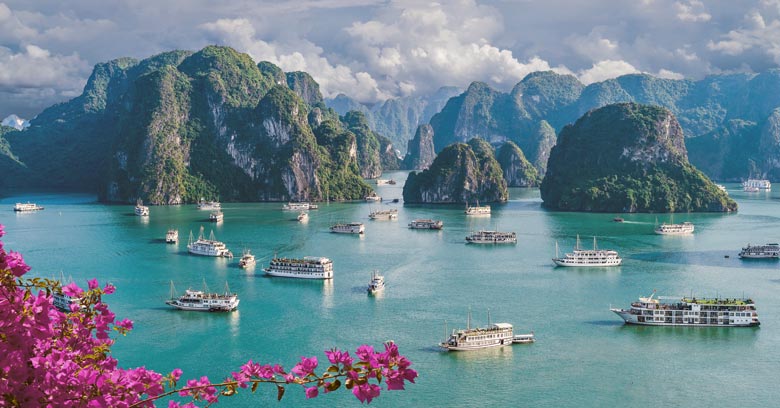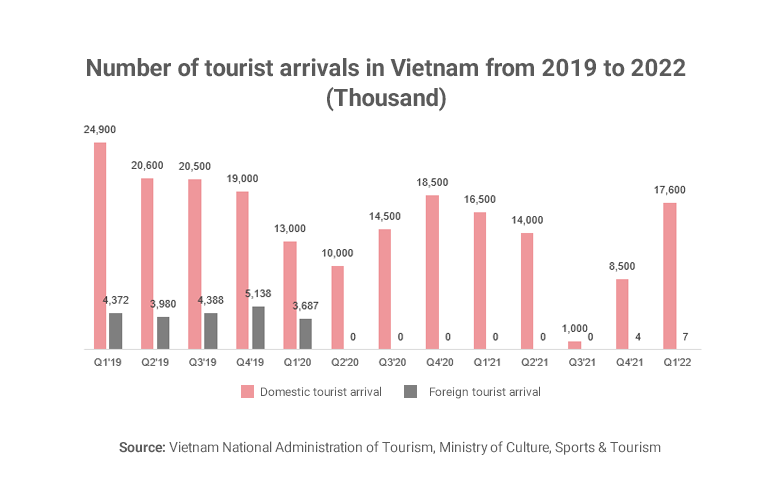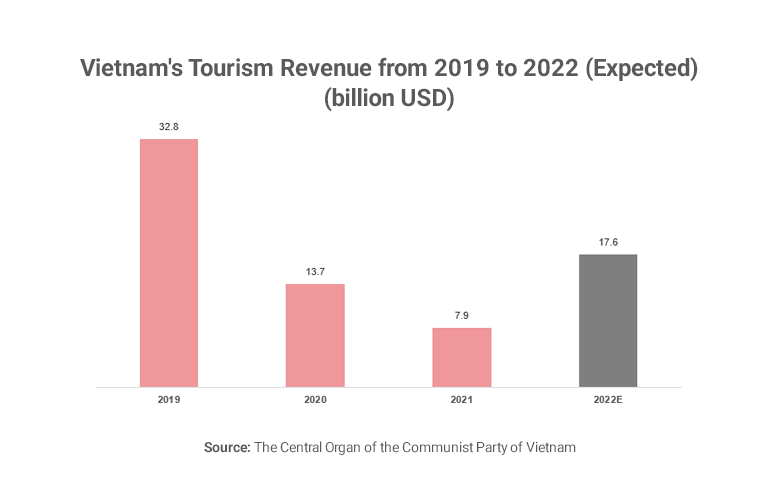
After two years of complete closure due to the pandemic, Vietnam finally re-opened to international tourists on March 15th, raising hopes for the recovery of the country’s tourism industry to pre-pandemic conditions.
Like many other countries, Vietnam’s tourism was severely affected by travel restrictions imposed on foreign as well as local tourists. The tourism sector used to contribute nearly 33 billion USD (9.2%) to Vietnam’s GDP before the pandemic, with an impressive annual growth rate of 22.7%. According to the General Statistics Office of Vietnam, 2019 was a particularly prosperous year for Vietnam’s tourism when the country attracted an unprecedented number of more than 18 million international arrivals. Foreign tourism was the key driver to the whole sector as it contributed to 56% of Vietnam’s tourism revenue while accounting for only 17.3% of the total number of visitors. With such strong momentum, Vietnam set the target to reach 20 million international arrivals in 2020. The goal seemed achievable as Vietnam recorded 2 million foreign arrivals in January 2020. However, that ambition was completely disrupted by the emergence of COVID-19, forcing Vietnam to close its border from March 2020.
Due to border closure and restricted entry permits for foreigners, Vietnam recorded no new arrival in the remaining three quarters of 2020. During the time of border closure, entry permit was only granted for high-skilled foreign labourers and experts entering Vietnam for work. Amidst this gloomy period, the Vietnamese government launched many initiatives to promote domestic travelling and help the tourist sector survive the crisis. Despite these efforts, 2020 was still a rough year for Vietnam’s tourism when total revenue dropped to 13 billion USD (only around 41% of 2019).

Compared to other neighbouring countries, Vietnam had relatively good control of the pandemic in 2020, and was expecting to continue promoting domestic travels to keep the tourism sector stable while preparing to welcome international tourists in 2021. Unfortunately, 2021 was an even more unfortunate year for the entire nation, including tourism, as the fourth wave of COVID-19 forced many big cities to impose complete lock-downs for months. Domestic tourists, the only factor that helped maintain tourism activities, also drastically decreased in both number and spending, pushing the whole sector in an even more bleak situation. According to Vietnam’s National Administration of Tourism, more than 35% of tourist companies declared bankruptcy while half of the remaining 65% had to temporarily shut down their businesses due to the lack of operating capital. Moreover, around 70% of the workforce in the tourist industry lost their job while the remaining 30% continued working with significant pay cuts.
It was not until the last quarter of 2021 that the situation gradually started to improve. Lockdowns were finally lifted, and domestic travelling activities were slowly resumed. Moreover, with a high vaccination rate following national mass vaccination campaigns, Vietnam finally decided to welcome the first international tourists to selected areas using package tours and charter flights after nearly two years of no entry. Although Vietnam only welcomed a small number of international tourists during this pilot phase, it brought great hope to the whole tourism sector about a long-awaited recovery. The pilot plan was expected to pave way for a full reopening to international tourism in 2022.

Thanks to positive results from the pilot phase along with the high vaccination rate of a booster shot, the Vietnamese government decided to reopen the country starting March 15th, 2022. Vietnam agreed to resume its unilateral visa exemption policy for citizens from 13 countries including Belarus, Denmark, Finland, France, Germany, Italy, Japan, Norway, Russia, South Korea, Spain, Sweden, and the U.K when visiting Vietnam for less than 15 days. Besides, citizens of other countries can now apply for a visa online with an up-to-30-day duration of stay. International travellers are not required to undergo quarantine if they have a negative COVID-19 test result that uses the RT-PCR method (within 72 hours before departure) or the rapid antigen method (within 24 hours before arrival). This policy eases several burdens on tourists when travelling compared to other countries in Southeast Asia, making Vietnam a much more attractive destination. Moreover, international tourists’ interest in travelling to Vietnam has been growing since the beginning of 2022 when plans about re-opening the country were regularly mentioned by governmental officials. With such advantages, Vietnam expects to welcome five million international tourist arrivals and drive the total revenue of the tourism sector up to 17.6 billion in 2022 (around 53.6% of pre-pandemic levels). There are still many challenges and uncertainties lying ahead, but with swift actions and great support from the government, the recovery of Vietnam’s tourism is promising.
Read more about our experience in market entry & expansion or our other consulting services.
The insights provided in this article are for general informational purposes only and do not constitute financial advice. We do not warrant the reliability, suitability, or correctness of the content. Readers are advised to conduct independent research and consult with a qualified financial advisor before making any investment decisions. Investing in financial markets carries risks, including the risk of loss of principal. Past performance does not guarantee future results.
The views expressed herein are those of the author(s) and do not necessarily reflect the company's official policy. We disclaim any liability for any loss or damage arising from the use of or reliance on this article or its content. ARC Group relies on reliable sources, data, and individuals for its analysis, but accuracy cannot be guaranteed. Forward-looking information is based on subjective judgments about the future and should be used cautiously. We cannot guarantee the fulfillment of forecasts and forward-looking estimates. Any investment decisions based on our information should be independently made by the investor.
Readers are encouraged to assess their financial situation, risk tolerance, and investment objectives before making any financial decisions, seeking professional advice as needed.



